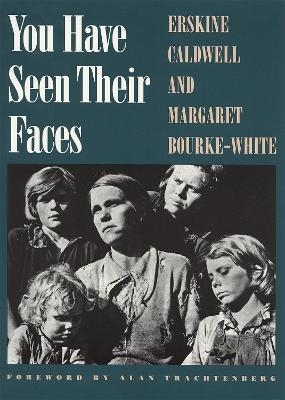
You Have Seen Their Faces
Seiten
2018
University of Georgia Press (Verlag)
978-0-8203-5587-0 (ISBN)
University of Georgia Press (Verlag)
978-0-8203-5587-0 (ISBN)
In the middle years of the Great Depression, Erskine Caldwell and photographer Margaret Bourke-White spent eighteen months travelling across the back roads of the Deep South to document the living conditions of the sharecropper. Their collaboration resulted in You Have Seen Their Faces, a graphic portrayal of America's rural underclass.
In the middle years of the Great Depression, Erskine Caldwell and photographer Margaret Bourke-White spent eighteen months traveling across the back roads of the Deep South—from South Carolina to Arkansas—to document the living conditions of the sharecropper. Their collaboration resulted in You Have Seen Their Faces, a graphic portrayal of America's desperately poor rural underclass. First published in 1937, it is a classic comparable to Jacob Riis's How the Other Half Lives and James Agee and Walker Evans's Let Us Now Praise Famous Men, which it preceded by more than three years.
Caldwell lets the poor speak for themselves. Supported by his commentary, they tell how the tenant system exploited whites and blacks alike and fostered animosity between them. Bourke-White, who sometimes waited hours for the right moment, captures her subjects in the shacks where they lived, the depleted fields where they plowed, and the churches where they worshipped.
In the middle years of the Great Depression, Erskine Caldwell and photographer Margaret Bourke-White spent eighteen months traveling across the back roads of the Deep South—from South Carolina to Arkansas—to document the living conditions of the sharecropper. Their collaboration resulted in You Have Seen Their Faces, a graphic portrayal of America's desperately poor rural underclass. First published in 1937, it is a classic comparable to Jacob Riis's How the Other Half Lives and James Agee and Walker Evans's Let Us Now Praise Famous Men, which it preceded by more than three years.
Caldwell lets the poor speak for themselves. Supported by his commentary, they tell how the tenant system exploited whites and blacks alike and fostered animosity between them. Bourke-White, who sometimes waited hours for the right moment, captures her subjects in the shacks where they lived, the depleted fields where they plowed, and the churches where they worshipped.
Erskine Caldwell (1903-1987) was born in Newnan, Georgia. He became one of America's most widely read, prolific, and critically debated writers, with a literary output of more than sixty titles. At the time of his death, Caldwell's books had sold eighty million copies worldwide in more than forty languages. He was elected to the American Academy of Arts and Letters in 1984.
| Erscheinungsdatum | 22.11.2018 |
|---|---|
| Reihe/Serie | Brown Thrasher Books |
| Illustrationen | Margaret Bourke-White |
| Vorwort | Alan Trachtenberg |
| Verlagsort | Georgia |
| Sprache | englisch |
| Maße | 216 x 279 mm |
| Gewicht | 333 g |
| Themenwelt | Kunst / Musik / Theater ► Fotokunst |
| Sachbuch/Ratgeber ► Freizeit / Hobby ► Fotografieren / Filmen | |
| Sozialwissenschaften ► Soziologie ► Makrosoziologie | |
| ISBN-10 | 0-8203-5587-9 / 0820355879 |
| ISBN-13 | 978-0-8203-5587-0 / 9780820355870 |
| Zustand | Neuware |
| Informationen gemäß Produktsicherheitsverordnung (GPSR) | |
| Haben Sie eine Frage zum Produkt? |
Mehr entdecken
aus dem Bereich
aus dem Bereich
Bilder machen, bearbeiten und verwalten mit Android-Handys und …
Buch | Softcover (2023)
dpunkt (Verlag)
24,90 €
Schwarzweißmotive erkennen und stimmungsvolle Bilder gestalten
Buch | Hardcover (2024)
dpunkt (Verlag)
49,90 €


